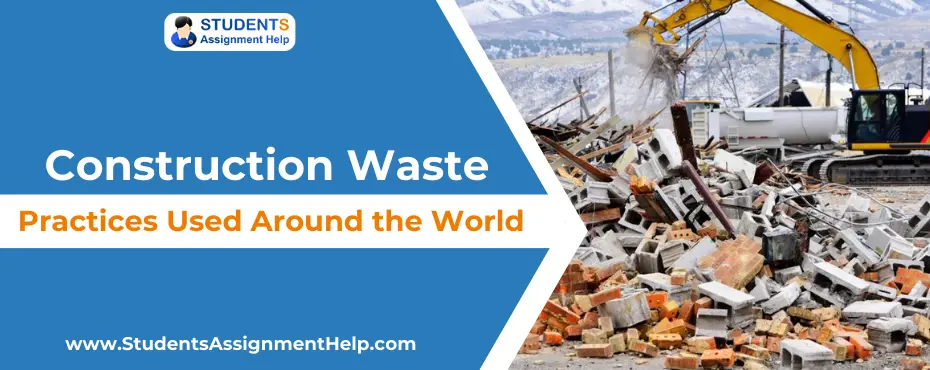Construction Waste: Practices Used Around the World

Introduction: Construction Waste Management
Construction waste is normally waste material or unwanted material produced from construction during demolition or renovation of buildings and roads. The components of construction waste are wood, drywall, brick, and concrete metal, plastic and sold waste materials such as electrical wiring, paper, etc. The construction waste is different from demolition waste.
The construction waste loads are transported to landfill places in the open trailer. It is an unwanted material that is either produced intentionally or accidentally by construction industries. The governments have formulated rules on the treatment of construction waste. In the given context, the paper will discuss the best practice prevailing in the world regarding the management of construction waste.
Flexible Rates Compatible With Everyone’s Budget
Hire a Professional Essay & Assignment Writer for completing your Academic Assessments
A growing number of construction activities has increased the burden on landfill loading. The construction waste is posing the serious hazardous impact on the environment. The waste poses threat to the economic stability of countries. Hence, there is the emergent need of finding practices that reduce the harmful impact on society.
Many countries have implemented the waste management strategy to reduce waste production (Construction waste management strategies 2008). Through rational management, the economy and environment of construction waste can be minimized. The Construction waste management plan has been introduced by many countries that provide guidance on waste management.
Practices in construction waste management
The most common best waste practice followed at local and global level is prevention, reuse, and recycle of waste.
Reducing or minimising the construction waste will save money, conserve energy and natural resources. The proper waste management will reduce air, water and soil pollution. The practice of waste prevention at all stages of the project by avoiding unnecessary demolition activities and minimising new construction activities. In Ireland practice of reuse and recycling, the construction waste is a holistic step towards building a sustainable green construction. The main emphasis of green building construction practice is on efficient use of resources.
In the reuse of waste practice, the material generated is on site and disposal of waste is the last step. The manager takes initiatives to reuse architectural feature in the refurbishment of existing structures on the same site. The salvage waste material is warehoused for future use. Many establish markets recycle waste timber for shuttering and hoarding. The recycle timber waste is sent for reprocessing for making a low-density flip board.
The construction waste is also used for filling materials in roads (Best Practice guidelines on the preparation of waste management plans for construction 2014). The one of the major component of construction also includes plastic. The practice of recycling plastic solid waste is an opportunity to society. The plastic solid waste is reprocessed to use it in the construction of new structures (Salem, Lettieri and Baeyens The countries like Netherland recycle construction waste particularly sand that create a logistics problem.
The new legislation emphasizes on minimising the disposal of sand. The practice increases the offer of sand by creating an efficient sand network (Barros, Dekker and The construction industry is one of the largest producers of waste in Hong Kong. The government has proposed the new practice of reducing waste production. The construction waste disposal charging scheme objective is to reduce waste generation. The strategy aims to maximise reuse and recycling of construction waste. The construction industry is instructed to use advance and less wasteful technologies (Construction waste 2014).
The best possible solution for reducing construction waste is by implementing construction waste management plan. The practice of minimising and diverting the waste from disposal to redirecting recyclable resources into the construction process is known as construction waste management.
The above figure describes the share of each component in construction waste. The industry by integrating CWM creates a win situation both for environment and bottom line. The CWM starts from planning, allocating responsibilities, identification of waste, identifying the way to manage waste and to organise the waste. The CWM plan is a continuous process that should be measured, updated and regularly reviewed.
The architect by developing CWM plan and reducing activities that result in the creation of waste on site of the project will help in implementing the sustainability goals. The successful CWM framework involves all the parties of the project such as owner, architect, project manager, contractor, etc. By involving parties in the design process, it becomes easier to achieve established goals.
The contractor in CWM plan is required to minimise waste and develop new ways of reusing extending waste materials in the new design. The architect is responsible for setting waste management goal for contractor and should be familiar with regional waste management structure. The CWM plan provides ways to prevent waste such packaging waste can be reduced by purchasing items in bulk. The nonreturnable packaging and containers on site should be recycled.
The CWM plan emphasizes on building material efficient infrastructure. The nonreturnable or recycle packaging should be donated to the local organisation. The practice of choosing construction manager who will be responsible for managing the waste issues at various level of project. To make CWM plan implementation effective the regular checks and audit is carried out on site that focuses on waste output for each operation (Construction waste management strategies 2008).
(Source: United Nation Environment Programme 2012)
The effective waste recycling can be achieved by mixing wastes with inert fractions such as cement, bitumen, clay to produce construction materials rather merely diluting the wastes. The materials produce from recycle should meet technical construction and environmental requirements. Constructor is advised to plan the construction process so as to eliminate or reduce wastage. The recycling of waste reduces cost (Cossu 2010).
Conclusion
Construction waste is one of the major environmental and economical issues in developing and developed countries of the world. Waste crises have increased because landfill spaces have been exhausted, and new space is the painstaking process. The rising awareness for environmental protection has high demand for providing an integrated solution to waste the problem. Construction waste is one-fourth of all waste generated in many countries. Hence, government is taking serious note on waste prevention and reduction (Bates 2006). In comparison to municipal waste, the source and components of construction waste are easily identified.
Many countries such as Singapore are now actively practicing waste prevention and setting zero waste targets as their primary mission. The various strategies employ are promoting waste recycling. The practice of implementing a voluntary package programme to reduce packaging waste. The practice of recycling commercial and industrial waste focuses on promoting environmental sustainability (Teo 207). The implementation CWM plan benefits community and industry as a whole by saving time, money, protects th environment and improves future management of projects. Hence, it can be concluded the CWM plan is the best possible practice to be followed for building sustainable environment.
Stuck with a lot of homework assignments and feeling stressed ?
Take professional academic assistance & Get 100% Plagiarism free papers
References
Barros, A., Dekker, R. And Scholten, V. 1998. A two-level network for recycling sand. European Journal of operation research, 110 (2), 199-214.
Bates, M. 2006. Compact’ Concept Comes of Age: How Specialist Manufacturers Construction waste management strategies. 2008. [Online]. Available at: https://www.aia.org/aiaucmp/groups/secure/documents/pdf/aiap072739.pdf[Accessed on: 5 Oct 2014].
Construction waste. 2014. [Online]. Available at: https://www.gov.hk/en/residents/environment/waste/constructionwaste.htm[Accessed on: 5 Oct 2014].
Cossu, R. 2010. Waste and building materials. Waste Management, 30, 735-736.
Have Helped Create a New Market in Materials Recycling. Waste Management Management World, 8 (1).
Salem, S., Lettieri, P. And Baeyens, P. 2009. Recycling and recovery routes of plastic solid waste. Waste Management, 29(10), 2625-2643.
Teo, V. 2007. Integrated Thinking: Solid Waste Management in Singapore. Waste World, 7 (6).
Best Practice guidelines on the preparation of waste management plans for construction. 2014. [Online]. Available at: https://www.aia.org/aiaucmp/groups/secure/documents/pdf/aiap072739.pdf [Accessed on: 5 Oct 2014].




